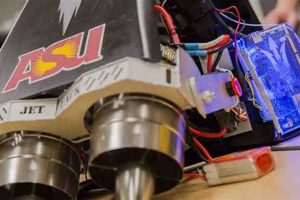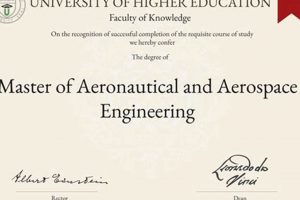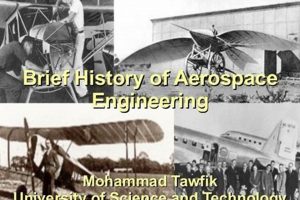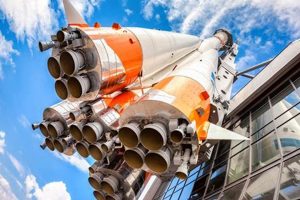The necessary academic qualifications for professionals designing, developing, and testing aircraft, spacecraft, and related systems typically involve a strong foundation in engineering principles. These qualifications are crucial for ensuring competence and innovation within the field. For example, a bachelor’s degree in aerospace engineering or a closely related field serves as a fundamental entry point.
The significance of possessing the appropriate academic credentials stems from the complex nature of aerospace engineering. The knowledge and skills acquired through formal instruction enable engineers to address intricate challenges in areas such as aerodynamics, propulsion, and structural mechanics. Historically, advancements in aerospace have been directly linked to improvements in educational programs that equip engineers with cutting-edge expertise.
The subsequent sections will delve into the specific degree programs, core coursework, and potential specialization options relevant to aspiring professionals in this demanding and rewarding discipline. Furthermore, the discussion will extend to the relevance of graduate studies and professional certifications in enhancing career prospects.
Guidance on Academic Preparation for Aerospace Engineering
Aspiring aerospace engineers can benefit from a strategic approach to their educational pursuits. The following points highlight key considerations for maximizing academic preparation and future career prospects.
Tip 1: Cultivate a Strong Foundation in Mathematics and Physics: A solid understanding of calculus, differential equations, linear algebra, and classical mechanics is essential. These subjects form the bedrock of aerospace engineering principles.
Tip 2: Select a Relevant Undergraduate Degree Program: A bachelor’s degree in aerospace engineering, or a closely related field such as mechanical engineering with a specialization in aerospace, is generally required. Coursework should include aerodynamics, propulsion, structures, and control systems.
Tip 3: Seek Out Hands-on Experience: Participation in internships, co-op programs, or research opportunities provides invaluable practical experience. These experiences allow students to apply theoretical knowledge to real-world engineering problems.
Tip 4: Develop Proficiency in Computer-Aided Design (CAD) and Simulation Software: Familiarity with industry-standard software such as CATIA, ANSYS, and MATLAB is highly advantageous. These tools are used extensively in the design, analysis, and simulation of aerospace systems.
Tip 5: Consider Pursuing Advanced Education: A master’s degree or doctorate can provide specialized knowledge and research skills, opening doors to advanced engineering roles and leadership positions.
Tip 6: Focus on Technical Writing and Communication Skills: Aerospace engineers must be able to clearly communicate complex technical information to colleagues, clients, and regulatory agencies. Developing strong writing and presentation skills is crucial.
Tip 7: Participate in Relevant Extracurricular Activities: Joining student organizations such as the American Institute of Aeronautics and Astronautics (AIAA) can provide networking opportunities and exposure to current industry trends.
Adhering to these guidelines can significantly enhance an individual’s preparedness for a successful career in aerospace engineering. A strong academic foundation, coupled with practical experience and professional development, is essential for meeting the demands of this challenging and rewarding field.
The subsequent sections will provide further details on career paths and required skill sets.
1. Bachelor's Degree
A bachelor’s degree represents the foundational cornerstone of academic achievement for aspiring aerospace engineers. This undergraduate education equips individuals with the fundamental knowledge and skills necessary to enter the profession, setting the stage for further specialization and advanced studies.
- Core Engineering Principles
A bachelor’s degree in aerospace engineering, or a closely related field such as mechanical or electrical engineering with a strong aerospace focus, provides a broad understanding of core engineering principles. These principles include thermodynamics, fluid mechanics, structural analysis, and control systems. This foundation is essential for understanding the behavior and performance of aerospace vehicles and related technologies.
- Specialized Aerospace Coursework
Within the undergraduate curriculum, students encounter specialized coursework tailored to aerospace applications. This may encompass aerodynamics, aircraft design, propulsion systems, spacecraft dynamics, and orbital mechanics. These courses enable students to apply general engineering principles to the specific challenges and requirements of the aerospace industry. For instance, students might learn to calculate lift and drag forces on aircraft wings or analyze the stability of satellite orbits.
- Mathematical and Computational Skills
A rigorous undergraduate program cultivates strong mathematical and computational skills. Aerospace engineering heavily relies on mathematical modeling, simulation, and data analysis. Students develop proficiency in calculus, differential equations, linear algebra, and numerical methods. They also gain experience using software tools for computer-aided design (CAD), finite element analysis (FEA), and computational fluid dynamics (CFD). These skills are essential for designing, analyzing, and optimizing aerospace systems.
- Laboratory and Design Experience
A crucial component of a bachelor’s degree is hands-on laboratory experience and design projects. Students engage in experiments, simulations, and team-based projects to apply theoretical knowledge to practical problems. This experiential learning fosters critical thinking, problem-solving skills, and the ability to work effectively in collaborative environments. Examples include designing and testing model aircraft, building and programming autonomous robots, or conducting wind tunnel experiments.
The comprehensive knowledge and skills gained through a bachelor’s degree form the indispensable base upon which aerospace engineers build their careers. While advanced degrees and specialized certifications may be pursued later, the undergraduate education provides the fundamental framework for understanding, designing, and innovating within the aerospace field. This initial educational investment is paramount for success in this demanding and technologically advanced industry.
2. Mathematics Proficiency
Mathematics proficiency stands as a cornerstone within the education requirements for aerospace engineers, underpinning the analytical and problem-solving skills critical to success in this field. It is not merely a prerequisite, but an integral component of the engineer’s toolkit, enabling the analysis, design, and optimization of complex aerospace systems.
- Calculus and Differential Equations
These mathematical disciplines provide the framework for understanding and modeling dynamic systems and rates of change. Aerospace engineers utilize calculus to analyze fluid flow, determine optimal trajectories, and design control systems. Differential equations are essential for modeling the motion of aircraft and spacecraft, as well as analyzing the behavior of electrical circuits and mechanical systems under varying conditions. Mastery of these concepts is indispensable for predicting and controlling the performance of aerospace vehicles.
- Linear Algebra
Linear algebra provides the tools to analyze and solve systems of linear equations, which arise frequently in aerospace engineering. Applications include structural analysis, where finite element methods rely on linear algebra to determine stress distributions within aircraft structures. Additionally, linear algebra is used in control systems design to analyze and stabilize the behavior of complex systems. Familiarity with vector spaces, matrices, and eigenvalues is crucial for understanding and manipulating data in a wide range of aerospace applications.
- Numerical Methods
Numerical methods are essential for solving problems that lack analytical solutions. In aerospace engineering, these methods are used extensively in computational fluid dynamics (CFD) simulations to model airflow around aircraft and spacecraft. They are also applied in finite element analysis (FEA) to analyze the structural integrity of components. Proficiency in numerical methods enables engineers to obtain accurate solutions to complex problems that would otherwise be intractable, facilitating the design and optimization of aerospace systems.
- Statistics and Probability
These branches of mathematics provide the foundation for uncertainty analysis and risk assessment. Aerospace engineers use statistics to analyze experimental data, validate models, and assess the reliability of systems. Probability theory is essential for quantifying the likelihood of failures and designing robust systems that can tolerate uncertainties. These skills are critical for ensuring the safety and reliability of aircraft, spacecraft, and related technologies.
Collectively, these mathematical disciplines equip aerospace engineers with the analytical capabilities necessary to address the intricate challenges inherent in the design, development, and operation of aerospace systems. A strong mathematical foundation is not just a checkbox item within the “education requirements for aerospace engineer,” but rather a fundamental enabler of innovation and progress in this demanding field.
3. Physics Foundation
A robust physics foundation is inextricably linked to the education necessary for aspiring aerospace engineers. Physics principles serve as the underlying framework for understanding and manipulating the natural laws governing the behavior of aerospace systems. Without a thorough grasp of physics, comprehending aerodynamics, propulsion, structural mechanics, and other core aerospace engineering disciplines becomes exceedingly difficult. For instance, understanding Newton’s laws of motion is paramount for analyzing the flight dynamics of an aircraft, while knowledge of thermodynamics is essential for designing efficient jet engines. The study of electromagnetism is crucial for designing and analyzing the electrical systems within an aircraft, including communication and navigation systems. Thus, physics acts as the causative agent behind the ability to succeed in subsequent engineering coursework.
The practical application of physics knowledge is evident throughout the aerospace industry. In designing a satellite, engineers rely on principles of orbital mechanics to predict its trajectory and ensure it remains in its designated orbit. When designing an aircraft wing, knowledge of fluid dynamics is used to optimize the wing’s shape for maximum lift and minimum drag. The structural integrity of an aircraft or spacecraft is assessed using principles of solid mechanics to analyze stress and strain distributions under various loading conditions. The development of new materials for aerospace applications relies heavily on solid-state physics to understand and manipulate the properties of these materials. These applications highlight the indispensable role of physics in the design, analysis, and operation of aerospace systems, and showcase the direct real-world significance of the “education requirements for aerospace engineer” focusing on physics.
In summary, a solid physics foundation is not merely a suggested prerequisite but an indispensable element within the overall academic preparation of an aerospace engineer. It provides the fundamental knowledge necessary to comprehend and apply the engineering principles that govern the design, analysis, and operation of aerospace systems. While the challenges in mastering physics concepts can be considerable, the rewards are immense, enabling engineers to innovate and push the boundaries of aerospace technology. The link to the broader theme of “education requirements for aerospace engineer” is clear: A diminished physics understanding directly impedes the ability to function effectively as an aerospace engineer.
4. Engineering Specialization
The pursuit of specific areas of expertise within engineering forms a critical aspect of the “education requirements for aerospace engineer.” While a broad foundation is essential, focused knowledge in a particular discipline allows for deeper engagement and contribution to the field’s advancements. This specialization often shapes an engineer’s career path and determines the nature of their work.
- Aerodynamics
Aerodynamics focuses on the study of air and its interaction with moving objects. Specialization in this area enables engineers to design efficient and stable aircraft wings, control surfaces, and overall airframe shapes. For example, an aerodynamicist might use computational fluid dynamics (CFD) simulations to optimize the wing design of a new commercial airliner, reducing drag and improving fuel efficiency. This specialization directly aligns with “education requirements for aerospace engineer” by providing the essential skills to manipulate airflow for enhanced vehicle performance.
- Propulsion
Propulsion involves the design and development of engines and systems that generate thrust. This specialization equips engineers to create more powerful, efficient, and environmentally friendly propulsion systems for aircraft and spacecraft. Consider an engineer working on the development of a new rocket engine for space exploration, aiming to increase thrust while reducing fuel consumption and emissions. Mastery of thermodynamics, combustion, and fluid mechanics is paramount for success in this specialization, fulfilling the “education requirements for aerospace engineer” for energy conversion and thrust generation.
- Structures
Structural engineering in aerospace centers on designing and analyzing the physical framework of aircraft and spacecraft. This area of expertise ensures that vehicles can withstand the stresses and strains encountered during flight or space travel. An aerospace structural engineer, for instance, might use finite element analysis (FEA) to simulate the effects of extreme temperatures and pressures on a spacecraft’s hull, ensuring its structural integrity during re-entry. “Education requirements for aerospace engineer” demand a deep understanding of materials science, stress analysis, and structural dynamics within this specialization.
- Control Systems
Control systems focuses on the design and implementation of systems that automatically control the behavior of aircraft and spacecraft. This specialization includes the development of autopilot systems, flight control algorithms, and guidance and navigation systems. An engineer specializing in control systems might develop a new autopilot algorithm that improves the stability and responsiveness of an aircraft during turbulent conditions. This specialization necessitates a strong background in mathematics, signal processing, and feedback control theory, fulfilling the mathematical aspects of “education requirements for aerospace engineer.”
These specializations, while distinct, are interconnected and essential to the broader field of aerospace engineering. The specific area of focus chosen by an engineer will significantly influence their day-to-day tasks, required skill set, and overall career trajectory, reinforcing the importance of specialization within “education requirements for aerospace engineer.” The selection process should be carefully considered, taking into account both personal interests and industry demands.
5. Software Familiarity
Software familiarity represents a crucial component of the academic qualifications for aerospace engineers. Modern aerospace engineering relies heavily on sophisticated software tools for design, analysis, simulation, and testing. Thus, proficiency in these software packages is not merely a desirable skill but an essential requirement for success in the profession.
- Computer-Aided Design (CAD) Software
CAD software, such as CATIA, SolidWorks, and AutoCAD, is used extensively in the design and drafting of aerospace components and systems. Aerospace engineers employ CAD tools to create detailed 3D models of aircraft fuselages, wings, engine components, and other critical parts. These models are then used for manufacturing, analysis, and simulation. Mastery of CAD software is essential for translating conceptual designs into tangible, manufacturable products and is therefore integral to the “education requirements for aerospace engineer”.
- Finite Element Analysis (FEA) Software
FEA software, including ANSYS and Abaqus, is used to analyze the structural integrity of aerospace components and systems under various loading conditions. Aerospace engineers use FEA to simulate the effects of stress, strain, temperature, and vibration on aircraft structures, ensuring they can withstand the rigors of flight. This proficiency is critical for ensuring the safety and reliability of aerospace vehicles. Therefore, FEA software knowledge represents the “education requirements for aerospace engineer” in structural analysis.
- Computational Fluid Dynamics (CFD) Software
CFD software, such as Fluent and Star-CCM+, is used to simulate the flow of air and other fluids around aerospace vehicles. Aerospace engineers use CFD to optimize the aerodynamic performance of aircraft wings, engine inlets, and other components, minimizing drag and maximizing lift. CFD simulations provide valuable insights into flow behavior that would be difficult or impossible to obtain through physical experiments, solidifying its place in “education requirements for aerospace engineer”.
- MATLAB and Simulink
MATLAB and Simulink are widely used for mathematical modeling, simulation, and control system design in aerospace engineering. Aerospace engineers use MATLAB to develop algorithms for flight control systems, analyze data from flight tests, and simulate the performance of aerospace systems. Simulink provides a graphical environment for modeling and simulating dynamic systems, allowing engineers to design and test control systems before implementing them in hardware. The analytical and simulation strength puts MATLAB and Simulink within “education requirements for aerospace engineer”.
In conclusion, the mastery of these software tools is no longer viewed as an optional skill but an indispensable attribute for individuals pursuing a career in aerospace engineering. The ability to effectively utilize CAD, FEA, CFD, MATLAB, and Simulink directly impacts an engineer’s capacity to design, analyze, and optimize aerospace systems, thereby reinforcing the vital connection between software proficiency and the core essence of the “education requirements for aerospace engineer.”
6. Continuous Learning
The dynamic nature of aerospace technology mandates continuous learning as an indispensable component of the academic and professional trajectory for aerospace engineers. The initial formal “education requirements for aerospace engineer”, encompassing a bachelor’s or advanced degree, provides a fundamental knowledge base. However, the rapid pace of innovation within the field necessitates ongoing acquisition of new skills and knowledge to maintain competence and contribute meaningfully. A static skillset quickly becomes obsolete in an environment characterized by evolving materials, propulsion systems, avionics, and regulatory standards. Therefore, the adherence to the principles of continuous learning becomes a defining factor between professional stagnation and career advancement within the industry. This requirement isn’t just a suggestion; it represents an adaptive response to the constant influx of new technologies and methodologies.
The implications of neglecting continuous learning are significant. Consider an engineer who graduated a decade ago and has not actively pursued further training or education. This individual may lack familiarity with composite materials, advanced simulation techniques, or the latest regulatory requirements for unmanned aerial vehicles (UAVs). Consequently, they might be unable to contribute effectively to projects involving these technologies, potentially hindering their career progression and limiting their organization’s competitiveness. Conversely, an engineer actively engaged in continuous learning through professional development courses, conferences, or self-study remains abreast of industry trends and possesses the skills to tackle emerging challenges. This proactive approach directly translates into enhanced problem-solving capabilities, increased innovation, and improved project outcomes. For example, knowledge of emerging technologies like additive manufacturing or AI-driven design optimization directly enhances engineering capabilities.
In summary, continuous learning constitutes an inextricable extension of the “education requirements for aerospace engineer.” It functions as a critical mechanism for adapting to technological advancements, maintaining professional relevance, and contributing to the ongoing evolution of the aerospace industry. While initial formal education establishes a foundational framework, a commitment to lifelong learning ensures engineers possess the necessary expertise to navigate the complexities of this dynamic field. The potential challenges associated with time management and resource allocation are offset by the long-term benefits of sustained professional growth and enhanced career prospects. The ongoing pursuit of knowledge is not merely a recommendation; it is a professional imperative.
Frequently Asked Questions
The following provides answers to commonly asked questions regarding the academic qualifications necessary for a career in aerospace engineering.
Question 1: Is a bachelor’s degree in aerospace engineering absolutely required?
While a bachelor’s degree in aerospace engineering is the most direct path, related fields such as mechanical or electrical engineering, with a strong focus on aerospace-related coursework, can also provide a viable foundation. However, supplemental coursework or a graduate degree in aerospace engineering may be necessary to acquire the specialized knowledge required for certain roles.
Question 2: How important are internships and co-op programs?
Internships and co-op programs are highly valuable. They provide practical experience, networking opportunities, and a deeper understanding of the aerospace industry. Many employers prioritize candidates with relevant internship experience.
Question 3: What mathematical skills are most crucial?
A strong foundation in calculus, differential equations, linear algebra, and statistics is essential. These mathematical disciplines underpin many of the core principles in aerospace engineering.
Question 4: Is a graduate degree necessary for career advancement?
While not always mandatory for entry-level positions, a master’s degree or doctorate can significantly enhance career prospects, especially for roles involving research, development, or leadership. Advanced degrees provide specialized knowledge and research skills that are highly valued in the industry.
Question 5: What software skills are employers looking for?
Proficiency in industry-standard software such as CATIA, ANSYS, MATLAB, and Simulink is highly desirable. These tools are used extensively in design, analysis, and simulation activities.
Question 6: How important is continuous professional development after graduation?
Continuous professional development is crucial due to the rapid pace of technological advancements in the aerospace industry. Engineers must actively engage in ongoing learning to maintain their competence and stay abreast of new developments.
In summary, securing a career in aerospace engineering requires a comprehensive understanding of both theoretical principles and practical applications. A commitment to lifelong learning is essential for sustained success.
The subsequent section will explore the skills required in addition to the education requirements.
Education Requirements for Aerospace Engineer
This exposition has detailed the essential “education requirements for aerospace engineer,” encompassing the foundational bachelor’s degree, crucial mathematical and physics proficiencies, specialized engineering knowledge, software familiarity, and the imperative of continuous learning. These elements collectively form the academic bedrock upon which successful careers in aerospace engineering are built.
Aspiring professionals are urged to meticulously cultivate these competencies, recognizing that the pursuit of excellence in these areas is not merely a prerequisite but a gateway to innovation and leadership within the dynamic aerospace sector. The ongoing demand for skilled engineers underscores the enduring significance of rigorous academic preparation and a steadfast commitment to lifelong learning, thus securing the future advancement of aerospace technology.







